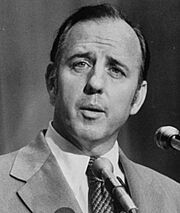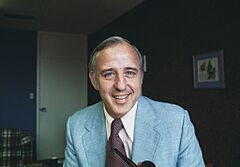Charles Goodell facts for kids
Quick facts for kids
Charles Goodell
|
|
|---|---|

Goodell in 1968
|
|
| United States Senator from New York |
|
| In office September 10, 1968 – January 3, 1971 |
|
| Appointed by | Nelson Rockefeller |
| Preceded by | Robert F. Kennedy |
| Succeeded by | James L. Buckley |
| Member of the U.S. House of Representatives from New York |
|
| In office May 26, 1959 – September 9, 1968 |
|
| Preceded by | Daniel A. Reed |
| Succeeded by | James F. Hastings |
| Constituency | 43rd district (1959–1963) 38th district (1963–1968) |
| Personal details | |
| Born |
Charles Ellsworth Goodell Jr.
March 16, 1926 Jamestown, New York, U.S. |
| Died | January 21, 1987 (aged 60) Washington, D.C., U.S. |
| Political party | Republican |
| Spouses |
|
| Children | 4, including Roger |
| Relatives | Andy Goodell (nephew) |
| Alma mater | Williams College Yale University |
Charles Ellsworth Goodell Jr. (March 16, 1926 – January 21, 1987) was an American politician. He represented New York in the United States House of Representatives and the United States Senate.
He first became a representative in 1959. Later, in 1968, he was appointed to the Senate. This happened after the death of Senator Robert F. Kennedy. Goodell was also the father of Roger Goodell, who is now the commissioner of the National Football League.
Early Life and Education
Charles Goodell was born in Jamestown, New York. His parents were Francesca and Charles Ellsworth Goodell. He went to public schools in Jamestown.
He graduated from Williams College in 1948. Goodell served in the United States Navy from 1944 to 1946 during the World War II era. He also served in the United States Air Force from 1952 to 1953 during the Korean War.
Goodell studied law at Yale Law School, finishing in 1951. He also earned a master's degree in government from Yale in 1952. For a short time, he taught at Quinnipiac College. After becoming a lawyer, he started his own law practice in Jamestown.
Goodell was the great-grandson of William Goodell. William Goodell was a famous person who worked to end slavery.
Time in Congress
Goodell worked for the United States Department of Justice from 1954 to 1955. In 1959, he won a special election to become a Republican member of the United States House of Representatives. He filled a spot left open by the death of Daniel A. Reed. Goodell won with 65% of the votes.
He was reelected to the House three more times. While in the House, Goodell supported important laws. These included the Civil Rights Acts of 1960, 1964, and 1968. He also voted for the Voting Rights Act of 1965. These laws helped protect the rights of all Americans.
In September 1968, Goodell left the House of Representatives. He was appointed by Governor Nelson Rockefeller to the United States Senate. He took the place of Senator Robert F. Kennedy, who had died in June 1968.
As a Senator, Goodell became known for his more liberal views. He worked on many bills to help small towns and rural areas. For example, he helped create laws that provided money for sewage systems in small communities.
Goodell was also one of the strongest Republican voices against the Vietnam War. He believed the United States should withdraw from Vietnam. Many people who opposed the war praised his efforts.
In 1970, Goodell ran for his first full term as Senator. He had the support of the Republican and Liberal parties. However, the Republican Party was divided at the time. Many conservative voters chose to support other candidates.
In the November 1970 election, Goodell faced two main opponents. These were Richard Ottinger from the Democratic Party and James L. Buckley from the Conservative Party. Goodell and Ottinger split the votes of more liberal voters. This allowed Buckley, the Conservative Party candidate, to win the election. Goodell finished third with 24.3% of the votes.
Goodell was the last person to be appointed as a Senator from New York until 2009. That year, Kirsten Gillibrand was chosen to replace Hillary Clinton.
After Congress
After leaving Congress, Charles Goodell went back to working as a lawyer. In the mid-1970s, he helped President Gerald Ford. Goodell was part of a committee that created rules for people who avoided serving in the military during the Vietnam War.
Personal Life
Goodell married Jean Rice in 1954. They had five children: Bill, Tim, Roger, Michael, and Jeff. Roger Goodell is now the commissioner of the National Football League. Charles and Jean later divorced in 1978.
Goodell then married Patricia A. Goldman in 1978. Patricia worked in Congress and later served on the National Transportation Safety Board.
Charles Goodell lived in Washington, D.C. and Bronxville, New York. He passed away on January 21, 1987, due to complications after a heart attack. He was buried in Lakeview Cemetery in Jamestown.
Books
- Goodell, Charles E. Political Prisoners in America. New York: Random House, 1973.



